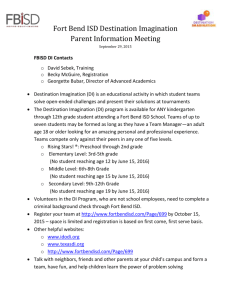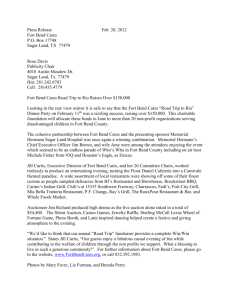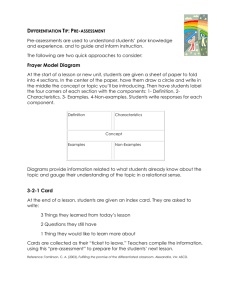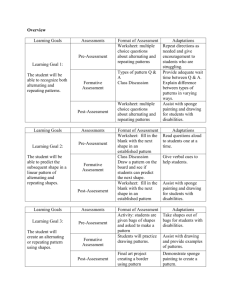Teacher Work Sample
advertisement
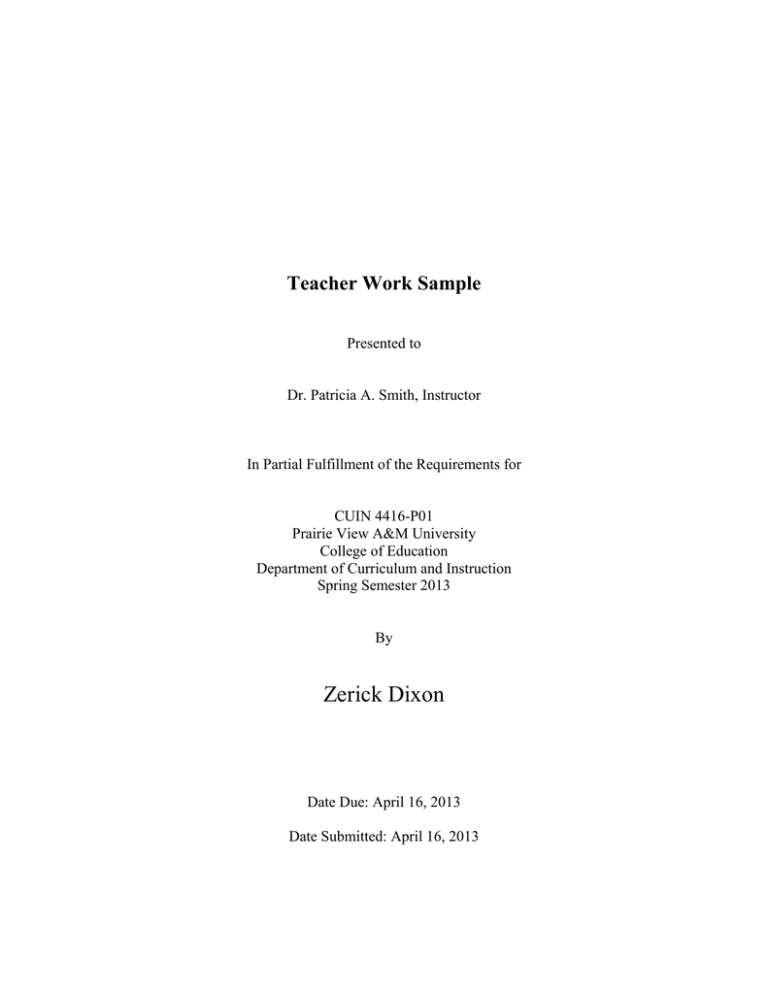
Teacher Work Sample Presented to Dr. Patricia A. Smith, Instructor In Partial Fulfillment of the Requirements for CUIN 4416-P01 Prairie View A&M University College of Education Department of Curriculum and Instruction Spring Semester 2013 By Zerick Dixon Date Due: April 16, 2013 Date Submitted: April 16, 2013 Table of Contents I. My Teaching Philosophy……………………….……………1 II. My Thoughts on E-FOLD-P…………………………………2 III. Contextual Factors…………………………………………3-13 IV. Objectives/Intended Learning Outcomes…………………14-16 V. Assessment Plan………………………………………… 17-21 VI. Design For Instruction…………………………………… 22-24 VII. Instructional Decision Making……………………………25-27 VIII. Analysis Of Student Learning…………………………….28-29 IX. Reflection and Self Evaluation……………………………30-31 X. References…………………………………………………...32 My Teaching Philosophy Education is the key to a great future. There have been many examples of people failing to achieve an education and being to struggle through the river of life’s trial and tribulations. It is up to teachers to be the facilitators. We must help guide young minds through the murky waters, to find their own path to greatness. To do this as a teacher, one must know their content, different instructional strategies, and their learners. Content is very important when teaching. A teacher must know what the content includes so he or she can provide quality educations. Educations that will help students pass their standardized exams and get into colleges and universities of great quality. Instructional strategies are also important. There are many different people in the world and not everyone learns at the same pace or method. Choose the right method can make the difference between poor educations versus quality educations. The learners are most likely the most important aspect of teaching. Knowing their strengths and weakness can help make more effective lessons and improve quality learning. By following these ideas I believe I can become a better educator to the minds of young children. 1 My Thoughts on E-FOLD-P E-FOLD-P (Educators as Facilitators of Learning for Diverse Populations) is very important to the framework of Prairie View A&M University. It helps ensure that future educators have the necessary tools and skills they need to become well-rounded facilitators of young minds. Educators must be able to solve problems and make quick decisions for instructing children. They must be aware of the diversity of their students and be able to grow and develop as facilitators. Educators must also be able to reflect on past triumphs and mistakes. These traits are important to creating a positive environment for young learners. It is my belief that, any teacher that follows this framework is already on their way of becoming the type of educator that enjoys teaching and sculpting students for a better future. 2 Contextual Factors TWS Standard: The teacher uses information about the learning/teaching context and student individual differences to set learning goals, plan instruction, and assess learning. 3 Community, School and Classroom Factors Missouri City, Texas, also known as, The Show Me City is located on U.S. Highway 90A and State Highway 6. The city is twenty miles southwest of downtown Houston in northeast Fort Bend and southwest Harris counties. Flag Seal Most of its income has traditionally been from ranching and farming, because Missouri City has never had a commercial or industrial base large enough to support its population. The population of Missouri City stayed around 100 from 1904 to 1960 and then started to grow quite rapidly. From 4,500 in 1970 it leapt to 24,533 in 1982. It was 31,000 in 1989, when the town had 250 businesses. Most of the residents commute and work in nearby Houston. In 1990 the population was 36,176. By 2000 the population reached 52,913 with 1,451 businesses. As of the 2010 U.S. Census, the city had a 4 population of 67,358. The racial makeup of the city, as of the 2010 U.S. Census, was 24.9% non-Hispanic White, 41.8% African American, 0.4% Native American, 16.2% Asian, and 2.9% from two or more races. Hispanic or Latino of any race was 15.3% of the population. The Fort Bend County portion of Missouri City is served by Fort Bend Independent School District, while the Harris County portion is served by Houston Independent School District. Fort Bend Independent School District (ISD) is the seventh largest school district in Texas. The school district houses more than 68,000 students in 67 schools and the student population increases by about 2,000 students every year. Fort Bend ISD plans to add 13 additional campuses by the year 2015, so it may accommodate their growing numbers. The school district has received both state and national recognition. A Houston Chronicle report named Fort Bend ISD the “best-ranked district” in the Houston area based on a study of at-risk children. Two of the district’s high schools rank in the top ten high schools in the area. Governor Rick Perry also recognized Fort Bend ISD as the “Fittest School District in Texas” in 2005 and 2006. Seventy-two high school students from the district were named semifinalists in the 2008 National Merit Scholarship Program. Also, the U.S. Department of Education named Fort Settlement Middle School a No Child Left Behind Blue Ribbon School in 2007. Fort Bend ISD also boasts a diverse 5 student population that contributes to these successes. More than 30% of the student population is African American, 24% is white, 23% is Hispanic, and more than 20% is Asian/Pacific Islander. These students represent a wide variety of cultural backgrounds. More than 80 languages and dialects are represented among Fort Bend ISD’s students and their families. As of 2010, 31.3% of student body in the school district was AfricanAmerican, 22.5% were White, 24.1% were Hispanic, 0.2% was Native American, and 21.9% were Asian/Islander. Picture of school below: 6 Picture of school logo below: Colors: Navy Blue, White, and Orange Mascot: Longhorns Billy J. Baines Middle School (BMS) opened in August 2006, and is named in honor of Mr. Billy Baines. BMS is Fort Bend ISD's 12th middle school and is located in Sienna Plantation. Sienna Plantation is a residential community located off State Highway 6 near the Houston Southwest Airport, about twenty miles southwest of Houston and six miles southeast of Missouri City in eastern Fort Bend County. The affluent subdivision is on land that has a long history as a sugar and cotton plantation. Sienna Plantation had a population of 1,896 in 2000. In 1959 after Missouri City School District and Sugar Land School District merged to become Fort Bend Independent School District, Superintendent L.P. Rodgers hired Mr. Billy Baines as principal of Arcola Elementary School. Approved by the School Board, Mr. Baines became the first African American Principal named in the newly formed Fort Bend ISD and went on to serve in several leadership roles before retiring in 1990. 7 Baines Middle School is a suburban school with 1,360 students and is rated Academically Acceptable by the Texas Education Agency (TEA). Students perform at the state average in passing TAKS scores. In 2010, according to the Public Schools Explorer, 27.3% of the school population was African-American. Whites made up 33.8%, Hispanics made up 28.8%, Native Americans consist of 0.1%, and Asians/Pacific Islanders made up 10.1%. Of the entire student population, 27.1% were Economically Disadvantaged, 29.6% were At-Risk students, and 7.7% were Limited English Proficient. Demographics of Billy Baines Middle School (2010) Asian/Pacific Islander Native American African-American 10.1 0.1 Hispanic 27.3 AfricanAmerican White 28.8 Hispanic Native American Asian/Pacific Islander 33.8 White http://www.texastribune.org/public-ed/explore/fort-bend-isd/billy-bainesmiddle-school/ 8 The school library is fully stock with many books for educational and entertainment purposes. The 8th grade science classroom has equitable amount of space for instruction. There are fifteen science tables arranged for cooperative learning, which can seat thirty students. There is one teacher’s desk, a SMART board attached to a whiteboard, and the sides of the room is lined with cabinets filled with supplies for students. There are also three computers with monitors in the back of the classroom, as well as a lockable cart for iPads, and an extra table available for guests to sit. Pictures of classroom shown below: 9 10 Characteristics of Students The six class periods are composed of 163 students in all, 78 of which are boys and 85, which are girls. Ethnicities range between African-American, Caucasian, and Hispanic. Each student is either thirteen or fourteen years old. Five out of the total 163 students have IEPs with accommodations for tests and quizzes. By appearance and comments from the teacher, it can be determined that many members of the class come from middle-income families with a few from low-income families. There are no true cultural differences within the group as a whole—they all coexist amicably. For the most part, the students look and act young, like the beginning/middle of puberty (ex. inability to focus). There is mix of intellect and ambition is varied as well. There are some students lacking in neither, both, or one or the other. All students speak English, but those of Hispanic descent are bilingual As a whole, the students thrive academically during artistic, kinesthetic, visual, and audio presentations of material. It is felt by the classroom teacher that the special education students will not usually complete assigned homework outside of the classroom, especially if it entails a large amount of reading; therefore much of the work is completed during the class hour. They generally have instructions read to them for clarification or the students take turns reading the instructions aloud, and several assignment questions are handled as a class before they are told to complete the work independently. 11 Students’ Varied Approach to Learning As a future teacher, I understand how students differ in their approaches to learning and I will make modifications in the instructional strategies that are appropriate for all students to learn the content of the lesson. I will assess all activities with a pre assessment in order to gain knowledge of each students abilities and how best to accommodate them. I will assist aids, professionals, and parents to ensure students with special needs are accommodated throughout the lesson. While presenting the lesson there will be various ways in which students learn. For those students in who are auditory learners, they are not only going to hear me talk and present the lessons, they are also allowed to talk and discuss the topic in class through the use of labs and experiments. For those students who are kinetic learners, or hands on learners, they will be given a chance to construct scientific models to enhance their understanding of the lessons. Throughout the lesson, I will keep in mind the various student differences like learning styles, cultural differences, and disabilities and adjust the instructional strategies accordingly. Students’ Skills and Prior Knowledge Once I entered the class, I discussed with my cooperating teacher the skills and prior knowledge of the students. During the course of the school year, the class learned units such as: Sun, Moon, and Earth during which the students learned about the moon phases and their effect on the tides. During the Earth, Ocean and Weather Systems unit they learned about the weather and its effects on the Earth. For the unit on Earth and 12 Space, Characteristics of the Universe, students learned about the planets and the life cycles of stars. Implications for Instructional Planning and Assessment As I design instruction and assess learning within the subject, I will need to acknowledge the socio-economic level of my students, since more than a few students come from low-income households with little parental involvement. Many will not have easy access to computers or assistance from other adults outside of the room, so they will need time in the classroom to complete assignments. Some lessons will be taught through the use of the classroom set of iPads, to ensure that the lessons are student-centered and completed in a timely fashion. I plan to also utilize the SMART board in lessons that requires teacher-led and student-led classroom discussions. I will attempt to integrate some independent work outside of the classroom to encourage some autonomous responsibility. I will also utilize the classroom’s design to form easily arranged cooperative learning groups in order to complete certain assignments in class. My goal is to aid in continuing the students’ success in all of their learning endeavors. 13 Objectives/Intended Learning Outcomes TWS Standard: The teacher sets significant, challenging, varied, and appropriate objectives. 14 For the unit of Chemistry, I will be using the Texas Essential Knowledge and Skills (TEKS) standards as set by the state legislature. I will ensure that the learning objectives are aligned with those standards. The learning objectives will also be based on the prior knowledge of the students to ensure connective learning. I will set high standards for all students to accomplish during every objective. Students will go through a forty-day plan mastering all learning objectives. Appropriate Learning Goals At the end of the unit students should will the arrangement of the Periodic Table of Elements and the different parts of an atom. Students will have an understanding of chemical formulas and chemical bonds. Students will understand the physical and chemical properties of the elements, as well as gain insight as to how chemistry affects their lives. TEKS Standards, 8th grade, Science (5) Matter and energy. The student knows that matter is composed of atoms and has chemical and physical properties. The student is expected to: (A) describe the structure of atoms, including the masses, electrical charges, and locations, of protons and neutrons in the nucleus and electrons in the electron cloud; (B) identify that protons determine an element’s identity and valence electrons determine its chemical properties, including reactivity; (C) interpret the arrangement of the Periodic Table, including groups and periods, to explain how properties are used to classify element; (D) recognize that chemical formulas are used to identify substances and determine the number of atoms of 15 each element in chemical formulas containing subscripts; (E) investigate how evidence of chemical reactions indicate that new substances with different properties are formed; and (F) recognize whether a chemical equation containing coefficients is balanced or not and how that relates to the law of conservation of mass. Objectives that Lead to the Goal By aligning the objectives with standards, they become appropriate and significant to the continued learning of the students. The objectives also clarify exactly what the students are expected to master by the end of the unit. The following shows the learning objectives aligned to the state standards. Learning Objectives 1. Students will identify each part of the structure of the atom. 2. Students will identify valence electrons of an atom and observe how the number of protons determines the element. 3. Students will classify which elements as metals, metalloids, or non-metals. Students will identify the periods and groups on the Periodic Table. 4. Student will read chemical formulas and identify the number of atoms of each element in a compound. 5. Students will identify new substances created through chemical reactions. 6. Students will identify chemical formulas as balance or unbalanced. TEKS Standard 5(A) describe the structure of atoms, including the masses, electrical charges, and locations, of protons and neutrons in the nucleus and electrons in the electron cloud; 5(B) identify that protons determine an element’s identity and valence electrons determine its chemical properties, including reactivity; 5(C) interpret the arrangement of the Periodic Table, including groups and periods, to explain how properties are used to classify element; 5(D) recognize that chemical formulas are used to identify substances and determine the number of atoms of each element in chemical formulas containing subscripts; 5(E) investigate how evidence of chemical reactions indicate that new substances with different properties are formed; and 5(F) recognize whether a chemical equation containing coefficients is balanced or not and how that relates to the law of conservation of mass. 16 Assessment Plan TWS Standard: The teacher uses multiple assessment modes and approaches aligned with objectives to assess student learning before, during, and after instruction. 17 Assessment Plan Overview for Learning Objectives The main goal of the Pre-Assessments is to identify what the students know about the subject and build on it. It is important to then monitor the progress of the students’ learning through a variety of method including, formal and informal assessments. In this class, the cooperating teacher uses weekly quizzes to help monitor students’ progress throughout instruction. After instruction, the students are given an End-of-Unit Test to check for the students’ mastery of the objectives. The following chart shows the assessment plans for each learning objective. Learning Objectives 1. Students will identify each part of the structure of the atom. Assessment Pre-Assessment Formative Assessment Post-Assessment Learning Assessment Objectives 2. Students will Pre-Assessment identify valence electrons of an atom and observe how the number of protons determines the element. Formative Assessment Post-Assessment Format of Assessment Matching activity with vocabulary words and definitions. Practice drawing Bohr models and classroom discussions. Students will complete a weekly quiz. Format of Assessment Using vocabulary words, students will identify valence electrons of different element and record observations. Monitor student observations for understanding. Students will complete a weekly quiz. 18 Adaptations Formative assessment will be done with heterogeneous grouping. Vary weekly quiz between multiple choice and short answer questions. Adaptations Informal assessment may be done through asking questions. Allow students to compare observations with each other. Vary weekly quiz between multiple choice and short answer questions. Learning Objectives 3. Students will classify which elements as metals, metalloids, or nonmetals. Students will identify the periods and groups on the Periodic Table. Learning Objectives 4. Student will read chemical formulas and identify the number of atoms of each element in a compound. Assessment Pre-Assessment Formative Assessment Post-Assessment Assessment Pre-Assessment Formative Assessment Post-Assessment Learning Objectives 5. Students will identify new substances created through chemical reactions. Assessment Pre-Assessment Formative Assessment Post-Assessment Format of Assessment Student will complete handout with six questions. Students will color Periodic Table and classify elements using colors. Students will complete a weekly quiz. Format of Assessment Students will use models of ball-andstick model to construct molecules using chemical formulas. Students will take notes and practice on How to Count Atoms worksheet. Students will complete a weekly quiz. Format of Assessment Students will complete KWL chart on chemical reactions. Students will complete a lab on chemical reactions. Students will complete a weekly quiz. 19 Adaptations Heterogeneous grouping during formative assessment. Vary weekly quiz between multiple choice and short answer questions. Adaptations Heterogeneous grouping during formative assessment. Vary weekly quiz between multiple choice and short answer questions. Adaptations Heterogeneous grouping during formative assessment. Vary weekly quiz between multiple choice and short answer questions. Learning Objectives 6. Students will identify chemical formulas as balance or unbalanced. Assessment Pre-Assessment Formative Assessment Post-Assessment Learning Objectives All Learning Objectives Assessment Post-Assessment Format of Assessment Students will complete handout with six questions. Use Think-PairShare strategy to monitor understanding. Students will complete a weekly quiz. Format of Assessment Students will complete End-ofUnit Test. Adaptations Heterogeneous grouping during formative assessment. Vary weekly quiz between multiple choice and short answer questions. Adaptations Vary end-of-unit test between multiple choice and short answer questions. Reliability, Validity, and Adaptations of End-of-Unit Assessment All the tests administered in the class are reliable. There are no questions and answers with typos or more than one correct answer. All of the tests given are valid assessments and are scored based on the number of correct items each student gets correct. To ensure that the students aren’t just memorizing the answer choices or sharing answers, several different versions of the test are provided to all students. When students are taking their test, they must have their dividers up so no accidental sharing of answers occur. Each test has an answer key used by the cooperating teacher. As for adaptations in assessment administration, my cooperating teacher and I would ensure that the students had a peaceful environment while taking their tests. If any child were being disruptive, we would separate them and administer their test individually. If a child needed extra 20 assistance with a word that may seem unfamiliar, we would gladly say it for them, then use it in a sentence to be certain that they understand the word. There were no students with learning disabilities in the class, only English Language Learners (ELLs). 21 Design For Instruction TWS Standard: The teacher designs instruction for specific learning objectives, student characteristics and need, and learning contexts. 22 Interpretation and Application of Pre-assessment Data The pre-assessments as I mentioned earlier in Section 3: Assessment Plan given to the students to see if they understand the topic and to learn what they do or do not know about the subject they are about to be introduced to. What I learned from the answers of the questions from the students is who is more familiar with the subject, who needs more help understanding the subject, and who has no idea what the subject is about. With that information, I am able to assist the cooperating teacher with small group instruction time and while she is aiding one group, I’ll be assisting another. Also, knowing what the students are familiar with helps set the pace of instruction. Based on pre-assessment and formative assessments given it proved necessary to re-teach and/or retest the content. Therefore, a warm-up consisting of 3 or more questions would be given at the beginning of every lesson. These will help to deepen understanding for some, and help re-teach the content for others. Use of Technology The cooperating teacher uses PowerPoint Presentations on the SMART board to engage her students using technology. The class set of iPads would also be used to teach lessons. With them students will be able to watch educational videos online to gain a better understanding of the lesson. Technology is used at least two times in the school day. 23 Lesson Plan for Learning Objective III: Grade: 8th Grade Science TEKS: 5(C) interpret the arrangement of the Periodic Table, including groups and periods, to explain how properties are used to classify element; Topic of Lesson: Students will classify which elements as metals, metalloids, or nonmetals. Students will identify the periods and groups on the Periodic Table. Objective of Lesson: Complete coloring and labeling of the Periodic Table. Steps in order of lesson: 1. Use a PowerPoint Presentation to take notes on the different families of elements. Take notes on metals, metalloids, and non-metals. 2. Identify and label the periods and groups on the Periodic Table. 3. Identify and label the families of the Periodic Table. 4. Identify and label which elements are metals, metalloids, or non-metals. 5. Use color pencils to color each family a different color and make a key. 6. Use markers to highlight metal, metalloids, non-metal and make a key. 7. Clean up 8. Assess students’ work for completion. Assign unfinished work for homework. Materials being used in lesson Pencil, Pen, notes, Periodic Tables (black and white), color pencils, and markers Assessment to check for comprehension “What did you learn about the families of elements?” “What did you learn about metals, metalloids, and non-metals?” (These are for my information on how well the students are grasping information. Closure “How could you apply did knowledge to your everyday life?” 24 Instructional Decision Making TWS Standard: The teacher uses ongoing analysis of student learning to make instructional decisions. 25 Instructional Decisions Based on Students’ Performance Using knowledge of my students based from concrete data, I was able to construct pacing schedule for this particular unit. The pre-assessment data gave me the notion that all students share comparable information of the unit. The cooperating teacher also noticed that some of the areas needed more clarification than others. More instructional time would be taken up by this modification. More time would be spent on focusing on valid points of the lesson, to ensure student comprehension. The modification would also serve to give more adequate time to prepare for the lessons. Some class periods were going at a faster pace than others. This required spending extra time on a lesson to give those who fell behind a chance to keep up with their peers. At times, it became necessary to re-test using a modified version of previous test. The modified version would focus more on content needed to meet learning objectives. If the students did not master the previous objective, they will not master the current objective. Instructional Decisions Based on Students’ Behavior Even though this modification was effective, other modifications appeared through student’s insubordinate and disruptive behavior. One modification that was made was to rearrange students seating. Some students were moved away from those that would distract their learning. There were a few students who were so disruptive, that they needed to be removed from class and sent to administration. Administration would then take other and discuss what disciplinary actions needed to be taken with the students. After the modification was enforced, the students’ behavior adjusted significantly. Throughout the lesson all students were good participants of the lesson. During the 26 classroom discussion majority of the students answered questions posed by the teacher. The students seemed to be appreciative and energized the activities and lesson. These modifications assisted students’ grasp and understanding of the content. Instructional Decisions Based on Unexpected Factors Some modification were made because unexpected factors. On day the electricity had temporarily gone out and the SMART board was not working. The lesson for the day incorporated the use of a video that helped introduce the concept of atoms. The cooperating teacher and I were forced to utilize the white board and have a teacher-led discussion on atoms. This allowed the lessons to continue, while using a different format for teaching the concept. 27 Analysis Of Student Learning TWS Standard: The teacher uses assessment data to profile student learning and communicate information about student progress and achievement. 28 Data of Students’ Performance Scores of the students of the given assessments show increase of mastery of TEK’s and Learning Objectives. The Pre-Assessments were a tool used to provide data to construct an affective lesson and activities for students understanding. The Post-Assessments were a tool used to provide data to judge whether students satisfied requirements for mastery. Tutorials may be needed for those who still haven’t mastered the concept of chemistry. The following is a graph comparing the performance of one group of students on Pre-Assessment and Post-Assessment. 29 Reflection and Self Evaluation TWS Standard: The teacher reflects on his or her instruction and student learning in order to improve teaching practice. 30 Reflection of Student Learning The things I have learned during the course of this unit have been educational. I have been able to learn about the students and their personalities. This has helped me to design instruction that will foster responsibility and growth in their learning. Throughout the course of this unit, I have been able to see how the students learn and how to best assess their learning. At first, the students had little or no knowledge of chemistry. After the Post-Assessment, a majority of them have mastered all the required learning objectives. Most students proved to do better when they learned though heterogeneous grouping and visual lessons. Using hands-on activities and connecting the content to realworld applications also served to enhance learning. This could not have been accomplished if the instruction were not aligned with the objectives and standards. Reflection for Future Teaching I believe the methods of instruction and assessment I learned during student teaching have helped to prepare me for my own classroom. I have gained many I ideas on how to present the content to the students and how to manipulate my classroom environment to maximize my students’ learning. I am grateful to my cooperating teacher for her assistance and knowledge that she has bestowed upon me, as well as, to Prairie View A&M University for preparing me for the experience of student teaching. With the skills I have learned, I will become a better teacher and continue to grow throughout my career. 31 References Betty Greenawalt Cox, "MISSOURI CITY, TX," Handbook of Texas Online http://www.tshaonline.org/handbook/online/articles/hem06), accessed Retrieved April 03, 2013. Published by the Texas State Historical Association from. ETools4Education, Region 4 - Fort Bend Independent School District http://www.online distance-learning-education.com/fort-bend-school-district.html, accessed April 03, 2013 Laurie E. Jasinski, "SIENNA PLANTATION, TX," Handbook of Texas Online http://www.tshaonline.org/handbook/online/articles/hjs36), accessed April 04, 2013. Published by the Texas State Historical Association. 32
